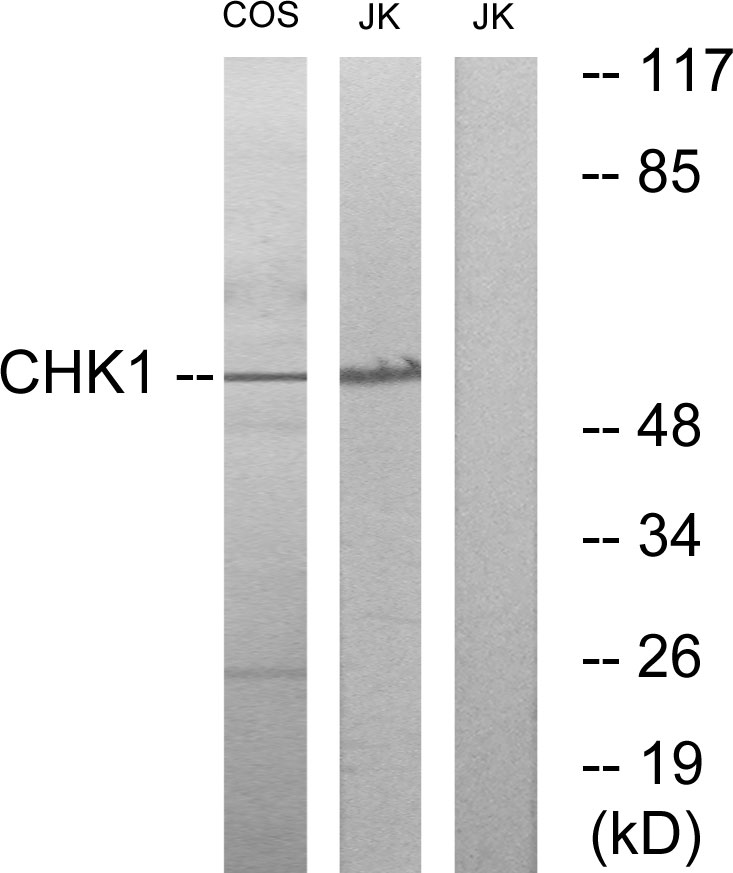Chk1 (phospho Ser345) antibody [C1C2], Internal
GTX100065
ApplicationsImmunoFluorescence, Western Blot, ImmunoCytoChemistry, ImmunoHistoChemistry, ImmunoHistoChemistry Paraffin
Product group Antibodies
ReactivityHuman, Mouse
TargetCHEK1
Overview
- SupplierGeneTex
- Product NameChk1 (phospho Ser345) antibody [C1C2], Internal
- Delivery Days Customer9
- Application Supplier NoteWB: 1:500-1:3000. ICC/IF: 1:100-1:1000. IHC-P: 1:100-1:1000. *Optimal dilutions/concentrations should be determined by the researcher.Not tested in other applications.
- ApplicationsImmunoFluorescence, Western Blot, ImmunoCytoChemistry, ImmunoHistoChemistry, ImmunoHistoChemistry Paraffin
- CertificationResearch Use Only
- ClonalityPolyclonal
- Concentration1.66 mg/ml
- ConjugateUnconjugated
- Gene ID1111
- Target nameCHEK1
- Target descriptioncheckpoint kinase 1
- Target synonymsCHK1, OZEMA21, serine/threonine-protein kinase Chk1, CHK1 checkpoint homolog, Checkpoint, S. pombe, homolog of, 1, Chk1-S, cell cycle checkpoint kinase
- HostRabbit
- IsotypeIgG
- Protein IDO14757
- Protein NameSerine/threonine-protein kinase Chk1
- Scientific DescriptionRequired for checkpoint mediated cell cycle arrest in response to DNA damage or the presence of unreplicated DNA. May also negatively regulate cell cycle progression during unperturbed cell cycles. Recognizes the substrate consensus sequence [R-X-X-S/T]. Binds to and phosphorylates CDC25A, CDC25B and CDC25C. Phosphorylation of CDC25A at Ser-178 and Thr-507 and phosphorylation of CDC25C at Ser-216 creates binding sites for 14-3-3 proteins which inhibit CDC25A and CDC25C. Phosphorylation of CDC25A at Ser-76, Ser-124, Ser-178, Ser-279 and Ser-293 promotes proteolysis of CDC25A. Inhibition of CDC25 activity leads to increased inhibitory tyrosine phosphorylation of CDK-cyclin complexes and blocks cell cycle progression. Binds to and phosphorylates RAD51 at Thr-309, which may enhance the association of RAD51 with chromatin and promote DNA repair by homologous recombination. Binds to and phosphorylates TLK1 at Ser-743, which prevents the TLK1-dependent phosphorylation of the chromatin assembly factor ASF1A. This may affect chromatin assembly during S phase or DNA repair. May also phosphorylate multiple sites within the C-terminus of TP53, which promotes activation of TP53 by acetylation and enhances suppression of cellular proliferation.
- ReactivityHuman, Mouse
- Storage Instruction-20°C or -80°C,2°C to 8°C
- UNSPSC12352203
References
- Yang C, Zhang X, Gao C, et al. NRBP1 negatively regulates SALL4 to reduce the invasion and migration, promote apoptosis and increase the sensitivity to chemotherapy drugs of breast cancer cells. Oncol Lett. 2022,23(4):139. doi: 10.3892/ol.2022.13259Read this paper
- Sakata R, Niwa K, Ugarte La Torre D, et al. Opening of cohesin's SMC ring is essential for timely DNA replication and DNA loop formation. Cell Rep. 2021,35(4):108999. doi: 10.1016/j.celrep.2021.108999Read this paper
- Subramanian GN, Greaney J, Wei Z, et al. Oocytes mount a noncanonical DNA damage response involving APC-Cdh1-mediated proteolysis. J Cell Biol. 2020,219(4). doi: 10.1083/jcb.201907213Read this paper
- Luo J, Luckenbaugh L, Hu H, et al. Involvement of Host ATR-CHK1 Pathway in Hepatitis B Virus Covalently Closed Circular DNA Formation. mBio. 2020,11(1). doi: 10.1128/mBio.03423-19Read this paper
- Hung CC, Chien CY, Chiang WF, et al. p22phox confers resistance to cisplatin, by blocking its entry into the nucleus. Oncotarget. 2015,6(6):4110-25.Read this paper




![Various whole cell extracts (30 microg) were separated by 10% SDS-PAGE, and the membrane was blotted with Chk1 antibody [ST57-09] (GTX01101) diluted at 1:500. The HRP-conjugated anti-rabbit IgG antibody (GTX213110-01) was used to detect the primary antibody, and the signal was developed with Trident ECL plus-Enhanced.](https://www.genetex.com/upload/website/prouct_img/normal/GTX01101/GTX01101_HM0401_20200317_WB_w_23053121_156.webp)
![WB analysis of HEK293T cells transfected with the pCMV6-ENTRY control (1) and pCMV6-ENTRY CHK1 cDNA (2) using GTX83385 Chk1 antibody [2G1D5].](https://www.genetex.com/upload/website/prouct_img/normal/GTX83385/GTX83385_20170912_WB_1_w_23061322_728.webp)